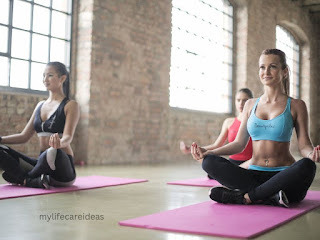10 Ways Yoga Actually Change Your Body
Yoga is a practice that has been used for thousands of years to improve both physical and mental well-being. It is a form of exercise that involves a series of poses, or asanas, which are designed to increase flexibility, strength, and balance. In addition to the physical benefits of yoga, it is also believed to have a positive impact on the mind and spirit.
Here are 10 ways that yoga can change your body:
1- Increases Flexibility:
Yoga poses are designed to stretch and lengthen the muscles, which can help to improve overall flexibility and range of motion.
2- Builds Strength:
3- Improves Balance:
4- Enhances Cardiovascular Health:
5- Enhances Lung Capacity:
6- Lowers Stress:
7- Increases Muscle Tone:
8- Improves digestion:
9- Improves Sleep:
10- Improves Overall Well-Being:
It's important to note that these benefits can vary based on the type and frequency of yoga you practice, as well as your overall health and fitness level. It's always a good idea to check with your doctor before starting any new exercise program, especially if you have any health conditions or injuries.
Your Immune System May Improve If You Do Yoga Every Day
Yes, there is some evidence to suggest that regular yoga practice may help to improve the function of the immune system.
The immune system is a complex network of cells, tissues, and organs that work together to protect the body from infection and disease. Stress, lack of physical activity, and poor diet can all have a negative impact on the immune system, making it less able to fight off illness and disease.
Yoga, on the other hand, has been shown to have a positive impact on the immune system in a number of ways. By reducing stress levels, yoga can help to decrease the amount of the hormone cortisol in the body, which can suppress the immune system. Additionally, regular yoga practice may also increase the number of immune cells in the body, such as T-cells, which are important for fighting off infections.
Yoga also improves your overall health and well-being, which in turn can positively impact the function of the immune system. However, it is important to note that it’s not a miracle cure for all illnesses. It is just a way to improve the overall function of the body, and it works best in conjunction with a healthy lifestyle, a balanced diet, and enough sleep.
It's always a good idea to check with your doctor before starting any new exercise program, especially if you have any health conditions or injuries.
Find Out What Type Of Yoga Is Best For You?
There are many different types of yoga, each with its own focus and emphasis. Here are a few of the most popular styles and what they're best known for:
1- Hatha yoga:
Hatha yoga is a general category that includes many different sub-styles of yoga. It is a slow-paced style of yoga that focuses on breath control and relaxation, making it a good choice for beginners.
2- Vinyasa Yoga:
3- Iyengar Yoga:
4- Ashtanga Yoga:
5- Restorative Yoga:
6- Bikram Yoga:
It's important to note that it is not always necessary to commit to one particular style, you can try different styles, and pick the one that best suits your needs and preferences. It's a good idea to try a few different classes with different teachers to see which style and teacher you like best. And remember that you can always adapt the practice according to your own limits and body condition.





0 Comments